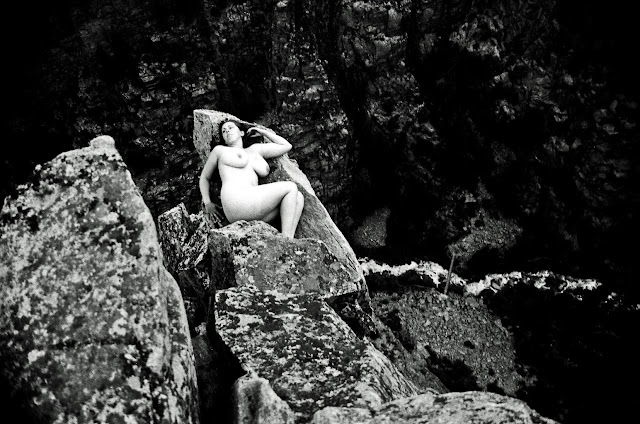 |
| Anonymous Abstract Portrait, Hanoi 2021 |
The evolution of color has taken us to new depths of imagination and has answered many questions on what is possible. Virtually any camera can see 16 million different colors or shades of a color. The very nature of color can't be discussed without talking about the color wheel, color spectrum, color theory, color grading, or color space. We get taught our colors in primary school and our first notion of a social class is determined by the size of your box of Crayola Crayons. Nope, I never had that box of 64 with the sharpener in the back. Mama said, I'd never use more than 16.
So why would we ever photograph anything in Black and White or change a color photograph to a stripped down monochromatic version of itself? Or even crazier, why buy a camera for $8,000 that ONLY shoots B&W? Well, here are a few good reasons why Black and White (monochrome) photography has remained so relevant.
 |
| River nude shot with Leica M Monochrome Type 246 with the 35mm Summicron on loan from Leica. They didn't appreciate me taking it out to the river, though. |
1. The Distraction of Color - The very first time this was explained to me, I didn't really see it. How is color a distraction? It's the real world as our brain perceives it! But I began photography with B&W film... Agfa, Kodak TMAX, Fomapan, Tri-X, Arista-EDU. All these were brands of film that had different qualities that rendered B&W tones that suited your style or purpose.
The absence of color in a composition left a photo with a clearer view of it's fundamental elements. You saw lines, shapes, shadow/light values, and contrast better. Texture popped out. It gave you a sense of form and balance within an image. Layering of depth and focus points become easily apparent and appreciated because you have reduced the photo to the basics and left it with only the properties that it needs by eliminating the frivolous.
 |
| Hanoi, Urban Rooftops, 2020 Sony a7rMkII |
2. Creates Drama - Fine Art Photography is all about emotion. How does a composition make you feel? Emotion is moved and manipulated via drama. A landscape photo with dramatic clouds can be further emphasized in Black & White because of the deeper tonal values and separation of highlight and shadow. But it also brings out facial emotions in street photography, portraits, and documentary work. If emotion is the primary target, go Black and White. If there is no relevant color information anyway, such as in some architecture photography, go Black and White.
 |
| Up in the Andes Mountains of Southern Peru |
3. Timelessness - Photography began it's existence in Black and White. It took 140 years before color became widely used. Many of the greatest and most influential photos taken in the world were done in B&W. It speaks to history, significance, and originality. It is almost synonymous with artistic style. That creditability is so consequential that when you turn a photograph B&W today, it borrows from our timeless past. We give it historical or artistic value just by losing the color, which has a tendency to modernize any photo.
 |
| Shot with film, 2006 Art Model, Mary posing on the side of a friggin' cliff. That's a bridge far below. |
“Black and white creates a strange dreamscape that color never can.”
– Jack Antonoff
4. Artsy - And speaking of artistic value... what is the number 1 thing we do when we want to "save" a bad color photo? Turn it Black and White! Instant improvement! And this is never better served more so than in abstract art, but not only that. Look up the most historically significant photos to date, almost all are Black and White or at least monochromatic. Interestingly enough, this mainly works in the medium of photographic art. How many black and white paintings do you see?
 |
| Just me... |
5. Easier on the Camera - This probably sounds like a trivial excuse to use Black and White, but hear me out. We're talking about helping the camera take a better picture. The camera can't see color at all. It only translates electrical signals as it gathers photons of light. Sensor tech uses color filters and algorithms and processors to determine the quantity of red, green, or blue, thus deriving all the other colors from those primary ones.
Well, when the camera doesn't have to work so hard for determining if a light signal is red, green, or blue... all it has to do is register tonal value! What do you get from that, deeper dynamic range and more latitude! Now you can partially understand why Leica makes an $8K camera. I've shot with it and it's remarkable! Hence the pic above.
 |
| Art Model, Katherine with Hades. Hades isn't a colorful hawk. Black and White is fine. |
Understandably, color still has a significant roll in photography. You do NOT change everything to B&W. You use color when it is part of the narrative, needs to appeal to a wide audience such as in marketing, and most significantly in video production. I photographed a playground once to test my theory in this. There was a definitive loss in the narrative when you miss out on the vibrant color of the playground.
Do wildlife photography and photograph a lion. No problem, you can go B&W or color. But try photographing a bird in the wild that has a distinct colorful plumage, like my personal favorite, the Kingfisher, and you've done yourself a disservice if you reduce it to monochrome values. Show me a rose without its color and I'll show you a failed experiment. Learn the difference and apply that wisdom well.

.jpg)
.jpg)
.jpg)
.jpg)